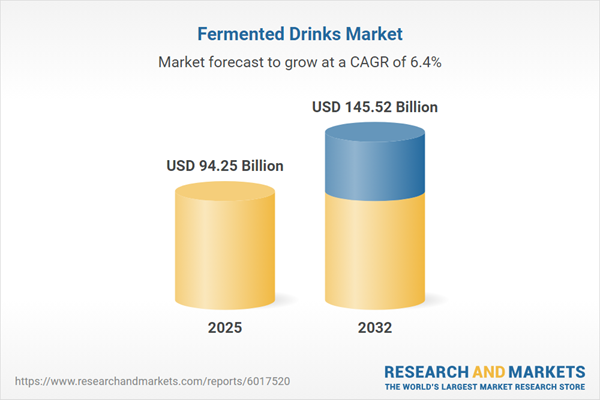Speak directly to the analyst to clarify any post sales queries you may have.
The fermented drinks market is rapidly evolving as brands leverage innovation, health trends, and shifting consumer preferences to capture new growth opportunities. Senior decision-makers will find actionable insights in this report, which offers granular analysis and strategic recommendations across product types, channels, and global regions.
Fermented Drinks Market Snapshot
The Fermented Drinks Market grew from USD 88.63 billion in 2024 to USD 94.25 billion in 2025 and is expected to sustain a CAGR of 6.39%, reaching USD 145.52 billion by 2032.
Scope & Segmentation
This report delivers comprehensive coverage of the fermented drinks market, mapping out key sub-segments, technology adoption, and regional performance for strategy-ready insights. The segmentation includes:
- Product Types: • Alcoholic (beer, cider, mead, sake, wine—red, rosé, sparkling, white) • Non alcoholic (kefir, kombucha, kvass)
- Distribution Channels: • Off trade (convenience stores, online retail, specialty stores, supermarket hypermarket) • On trade (event venues, hotel resorts, restaurants and bars)
- Packaging Types: • Bottle, can, carton box, keg, pouch
- Price Tiers: • Premium, standard, value
- Flavor Profiles: • Floral, fruit infused, herbal-spiced, traditional
- Consumer Age Groups: • Baby boomers, Gen X, Gen Z, millennials
- Geographic Coverage: • Americas (United States, Canada, Mexico, Brazil, Argentina, Chile, Colombia, Peru) • Europe, Middle East & Africa (United Kingdom, Germany, France, Russia, Italy, Spain, Netherlands, Sweden, Poland, Switzerland, United Arab Emirates, Saudi Arabia, Qatar, Turkey, Israel, South Africa, Nigeria, Egypt, Kenya) • Asia-Pacific (China, India, Japan, Australia, South Korea, Indonesia, Thailand, Malaysia, Singapore, Taiwan)
- Key Industry Players: • Yakult Honsha Co., Ltd. • Danone S.A. • Nestlé S.A. • Groupe Lactalis • Fonterra Co-operative Group Limited • Arla Foods amba • Royal FrieslandCampina N.V. • DMK Deutsches Milchkontor GmbH • Lifeway Foods, Inc. • PepsiCo, Inc.
Key Takeaways: Strategic Insights for Decision-Makers
- Consumer preferences are fragmenting, with a marked shift toward health-focused and functional fermented beverages offering probiotic and digestive benefits.
- Both alcoholic and non alcoholic segments are benefiting from artisanal production techniques and authentic storytelling, helping brands differentiate and build consumer loyalty.
- Regional market dynamics drive unique growth patterns. The Americas focus on premiumization and local sourcing. Europe, the Middle East, and Africa balance tradition and innovation, while Asia-Pacific’s dynamic demand is shaped by urbanization and government support for the beverage sector.
- Packaging innovation, such as the adoption of cartons and pouches alongside bottles and cans, is facilitating access to a wider range of retail formats and supporting sustainability objectives.
- Investment in ingredient transparency, eco-friendly production, and digital engagement channels is becoming a differentiator for brands aiming to capture evolving consumer segments.
Tariff Impact on Global Supply Chains
The introduction of United States tariffs in 2025 is raising supply chain complexity. Producers are actively reconfiguring sourcing strategies, turning to regional partners and alternative ingredients to maintain stability. Tariff-driven pressures are also shifting distribution priorities, favoring domestic over imported brands and altering product portfolios, with companies implementing rigorous risk management to remain agile in volatile trade environments.
Methodology & Data Sources
This market research employs a blend of primary and secondary data collection, including executive interviews, industry reports, and consumer surveys. Analytical approaches such as competitive benchmarking, value chain analysis, and risk assessment inform the findings. Every data point has been triangulated and quality-checked by subject matter experts to ensure accuracy and reliability.
Why This Report Matters
- Enables senior decision-makers to identify strategic growth levers and tailor product offerings to emerging consumer preferences and global market conditions.
- Equips organizations with insights to optimize production processes and supply chain resilience in light of regulatory shifts and evolving tariff landscapes.
- Offers a robust framework for benchmarking competitors, validating innovation priorities, and evaluating regional opportunities across the fermented drinks sector.
Conclusion
The fermented drinks market is marked by accelerated innovation, shifting health priorities, and increasing supply chain challenges. Leaders who leverage segmentation insights, invest in sustainability, and adapt to regional dynamics will secure a competitive advantage and drive sustained sector growth.
Additional Product Information:
- Purchase of this report includes 1 year online access with quarterly updates.
- This report can be updated on request. Please contact our Customer Experience team using the Ask a Question widget on our website.
Table of Contents
3. Executive Summary
4. Market Overview
7. Cumulative Impact of Artificial Intelligence 2025
Companies Mentioned
The companies profiled in this Fermented Drinks market report include:- Yakult Honsha Co., Ltd.
- Danone S.A.
- Nestlé S.A.
- Groupe Lactalis
- Fonterra Co-operative Group Limited
- Arla Foods amba
- Royal FrieslandCampina N.V.
- DMK Deutsches Milchkontor GmbH
- Lifeway Foods, Inc.
- PepsiCo, Inc.
Table Information
| Report Attribute | Details |
|---|---|
| No. of Pages | 197 |
| Published | October 2025 |
| Forecast Period | 2025 - 2032 |
| Estimated Market Value ( USD | $ 94.25 Billion |
| Forecasted Market Value ( USD | $ 145.52 Billion |
| Compound Annual Growth Rate | 6.3% |
| Regions Covered | Global |
| No. of Companies Mentioned | 11 |









